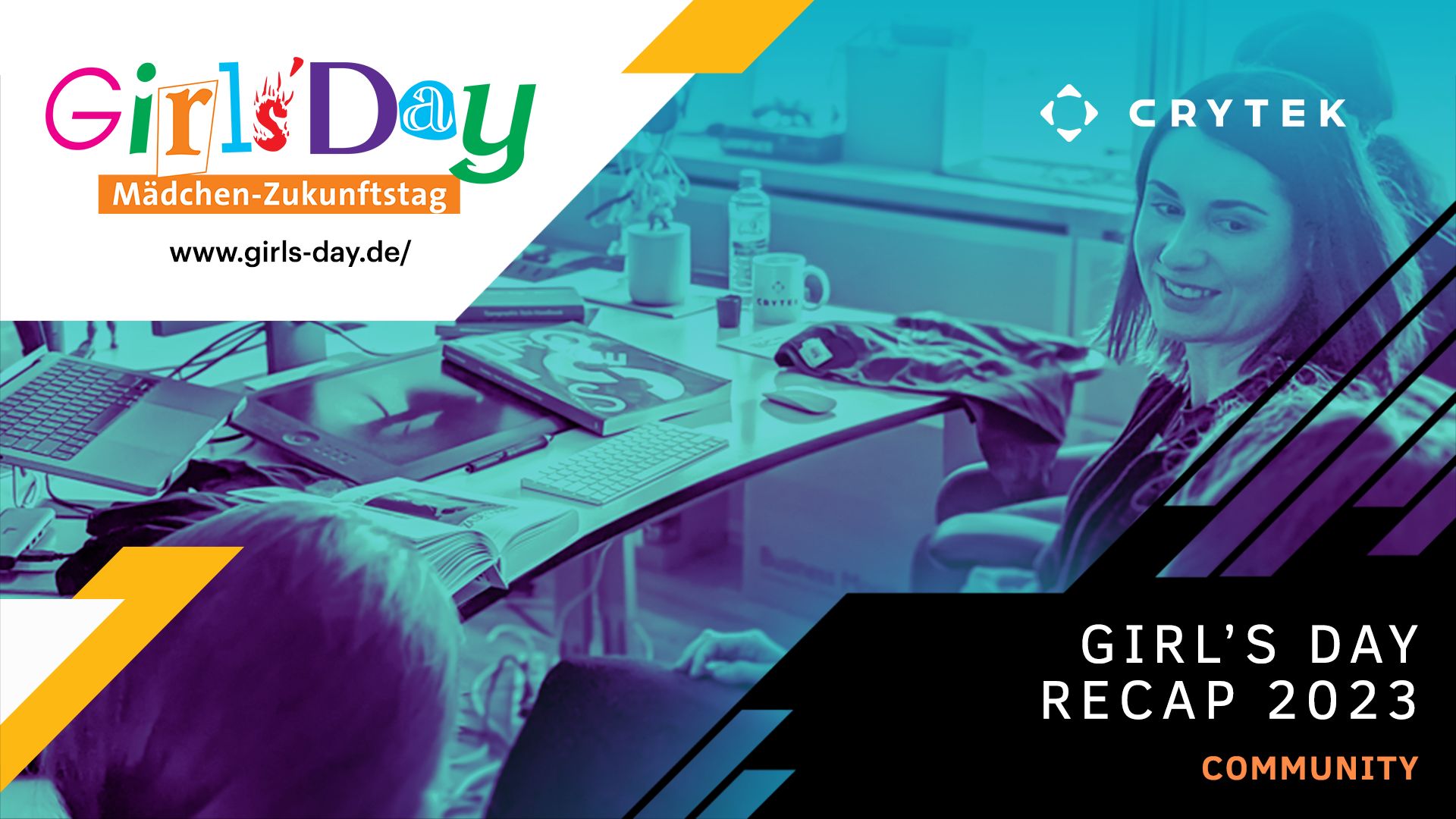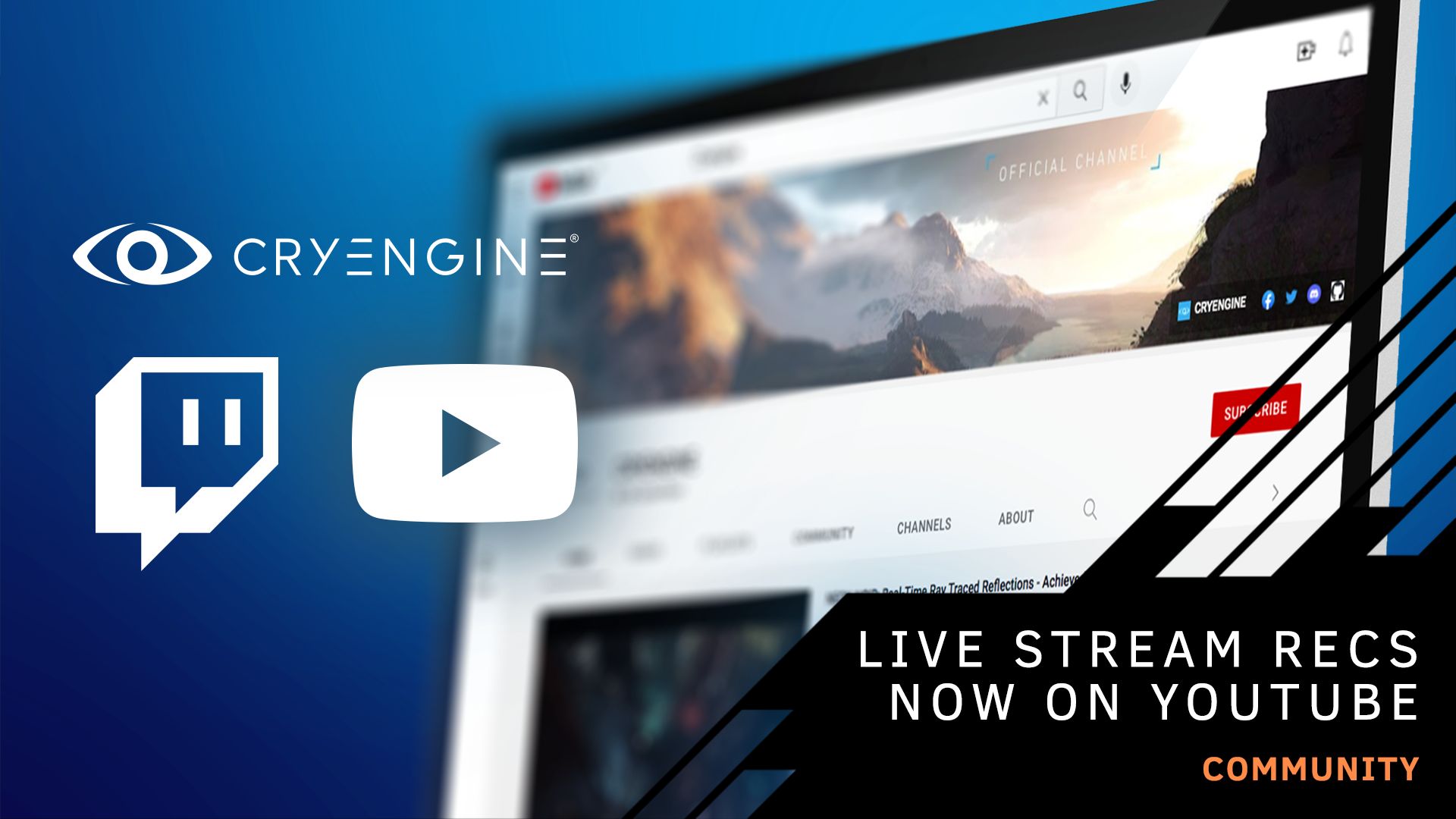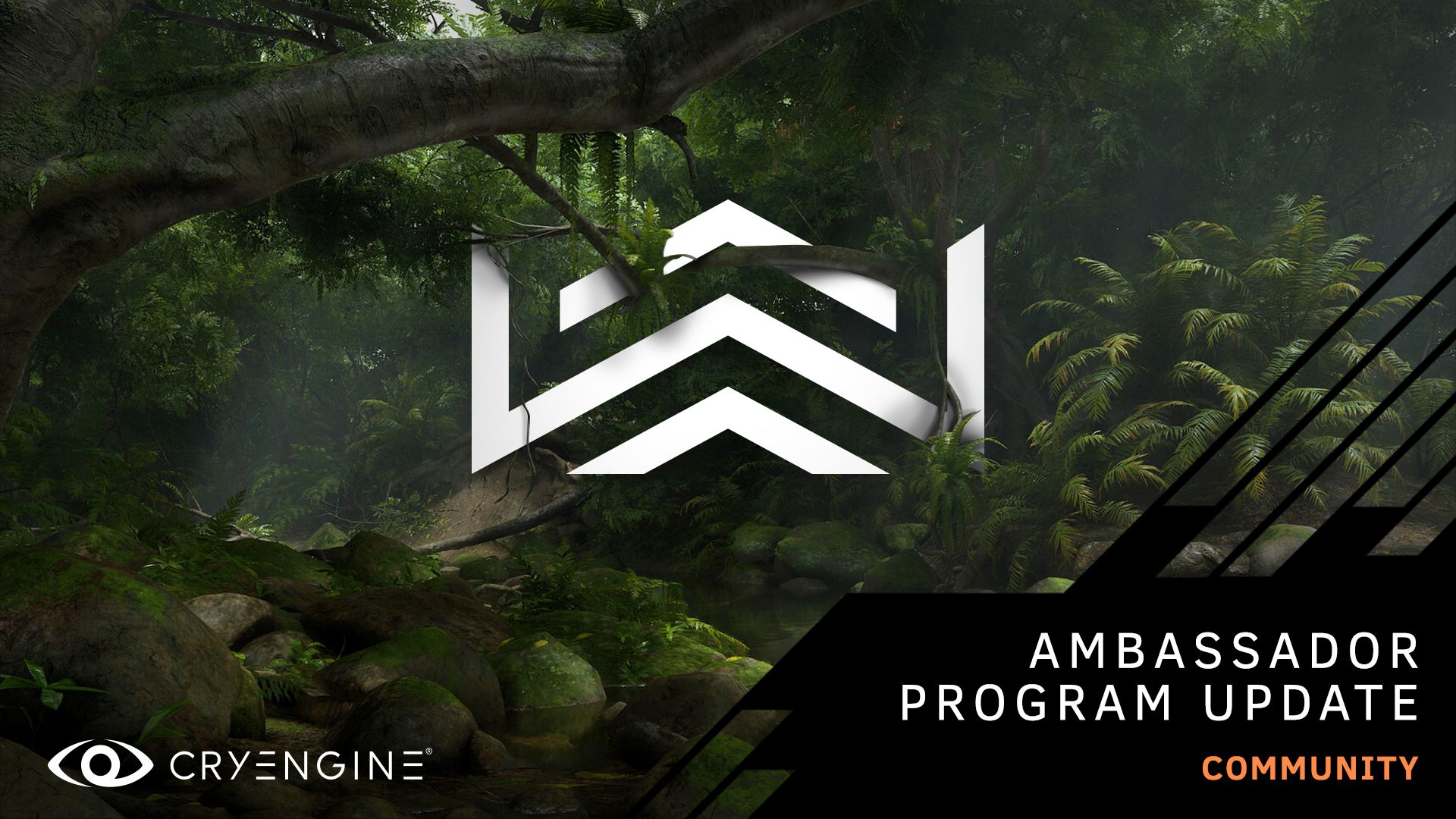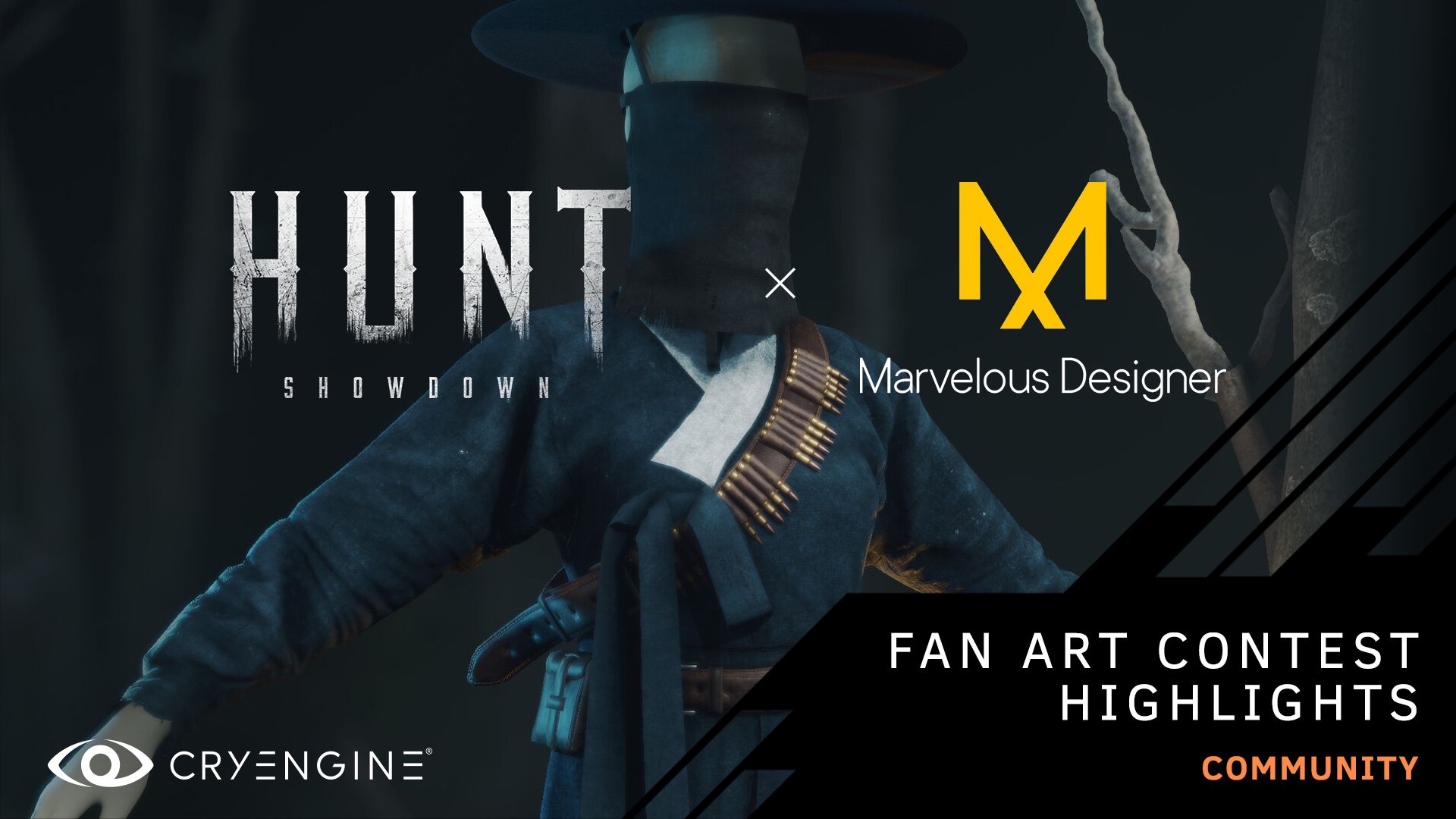
Hunt: Showdown x Marvelous Designer Fan Art Contest highlights
Our Hunt: Showdown 3D Apparel Creation Contest, hosted by Marvelous Designer, is still open for entries. Get advice from two of our community experts!
Do you fancy showing off your art skills and winning some fantastic prizes? Our Hunt: Showdown 3D Apparel Creation Contest, hosted by Marvelous Designer, is running until September 15, so there’s still time to get your entries in. All you have to do is design and screenshot your best hunter outfits and garments, and you could win swag, including NVIDIA graphics cards, perpetual Marvelous Designer licenses, and more. Marvelous Designer from CLO Virtual Fashion is a realistic cloth making program for 3D artists with a free 30-day trial. We have released a free asset pack on the CRYENGINE Marketplace containing everything you need to make garments for this contest, and you can check out our tutorial featuring a practical workflow to get you up and running. If you’re having any issues with downloading the assets, or want to pick up some advice, join our community on the official CRYENGINE Discord channel and sign up to the Marvelous Designer Discord channel.
Today, we’re catching up with two members of our CRYENGINE community, Dowon Choi and Ante Lovrić, who share their tips and tricks about crafting an entry for this contest. Head to the contest website to find out more about how to enter, and get first-hand advice in our Q&A below.
Hey guys, thanks for joining us! What’s your background with CRYENGINE?
Dowon: I live in South Korea, and I have worked on CG in various fields. My major is in modeling and concept art. I first learned about CRYENGINE in 2010 when I was at college. Pre-visualization research for the production of films was being conducted at the faculty where I was studying.
At that time, there was a project to incorporate the CRYENGINE sandbox as a pre-visualization tool. I was able to experience the powerful real-time visualization capabilities of the engine for the first time while working on that project. It was a period when real-time rendering was not very well developed, so I built up a lot of interest in CRYENGINE. I really appreciated the future and potential of real-time rendering and since then, CRYENGINE has become central to my work.
Most of my work with CRYENGINE is environment creation, and I like large-scale landscapes such as snow-capped mountains and deserts. CRYENGINE provides excellent functions for expressing my visions!
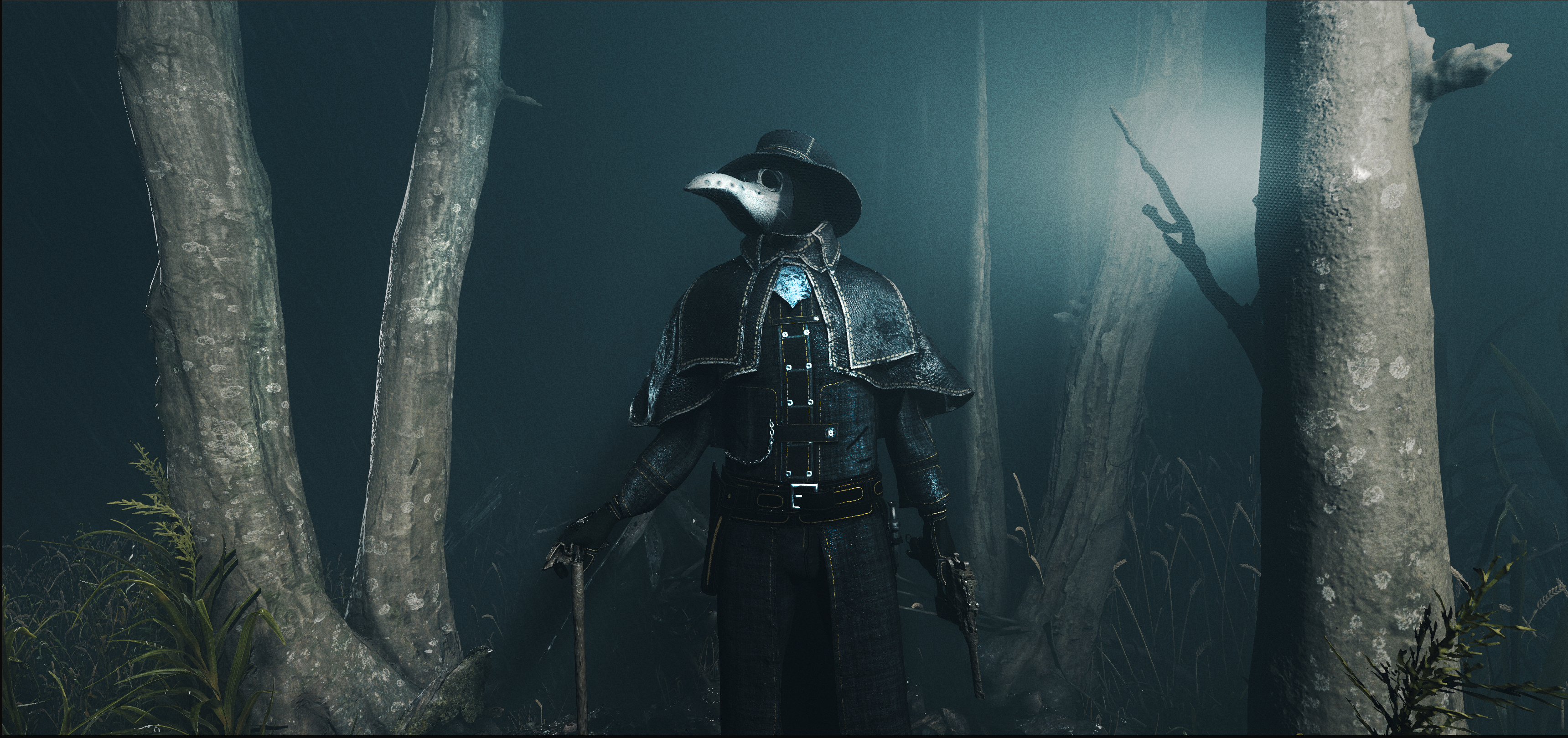
- Ante's contest entry is reminiscent of the iconic European plague doctor tradition to wear a beak-like mask, common during pandemics in the 17th, 18th &19th century in Europe.
Ante: I am from Croatia, from a small town in the region of Dalmatia called Sinj. The first time that I experienced CRYENGINE was back in 2008 when I got my hands on Crysis 1. It had a huge impact on gaming, especially for its graphics, and it was a game that marked my childhood. At the time, I was still very young, so I had no idea how the games were being made, but I knew that I wanted to make one for myself! Time went on, and I learned more and more about the game-making process.
Not long after, I finally had the chance to start making clothing mods for games such as Skyrim and Fallout. I was also invited to join in on Fallout 4: London, a fan-made DLC for the game. There were a lot of talented, experienced people, but also some who were beginners. It was an opportunity for me to learn from those that were better than me, and give tips about the process of making garments, optimization, texturing to the guys that were just starting out.
Last year my friends were talking about this game, Hunt: Showdown, which they got addicted to. They persuaded me to buy it and join in with them, and I enjoyed it a lot! When I started the game, I heard the crows flying in the loading screen and someone whispering "CRYENGINE." That’s when I knew this game is a big deal!
Now I had a lot more knowledge about 3D modeling and texturing, and the Hunt Contest came up just at the right time! This was the first time that I got the opportunity to test out CRYENGINE and its amazing features. I've been using the engine for about two months now, and it was a great learning experience. The community is friendly and helpful, devs were available nearly all the time, which is rare nowadays, and they have my respect for that. There are excellent streams to help us learn and the devs answer almost every single question that we ask of them!
Check out the model on sketchfab!
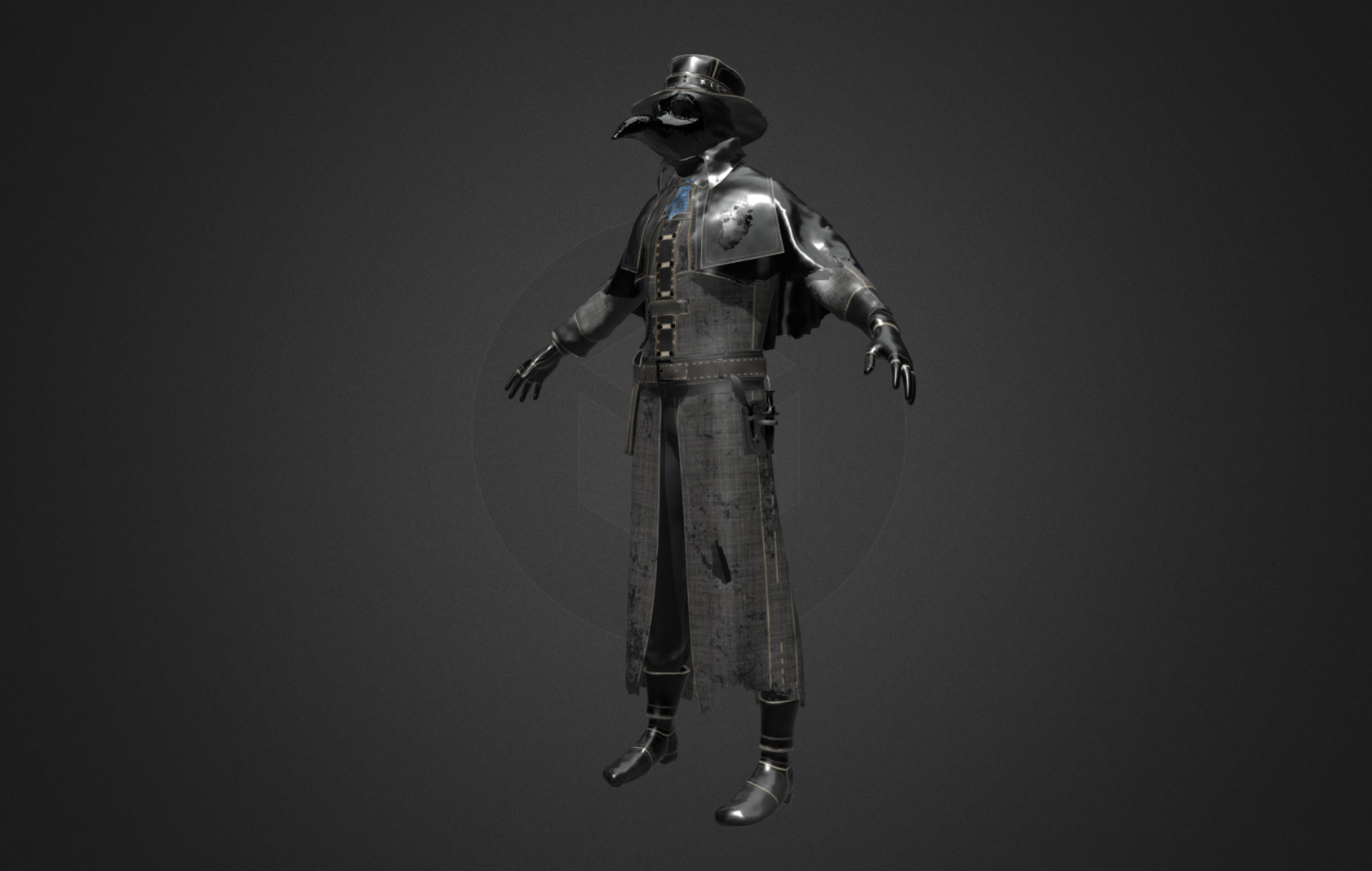
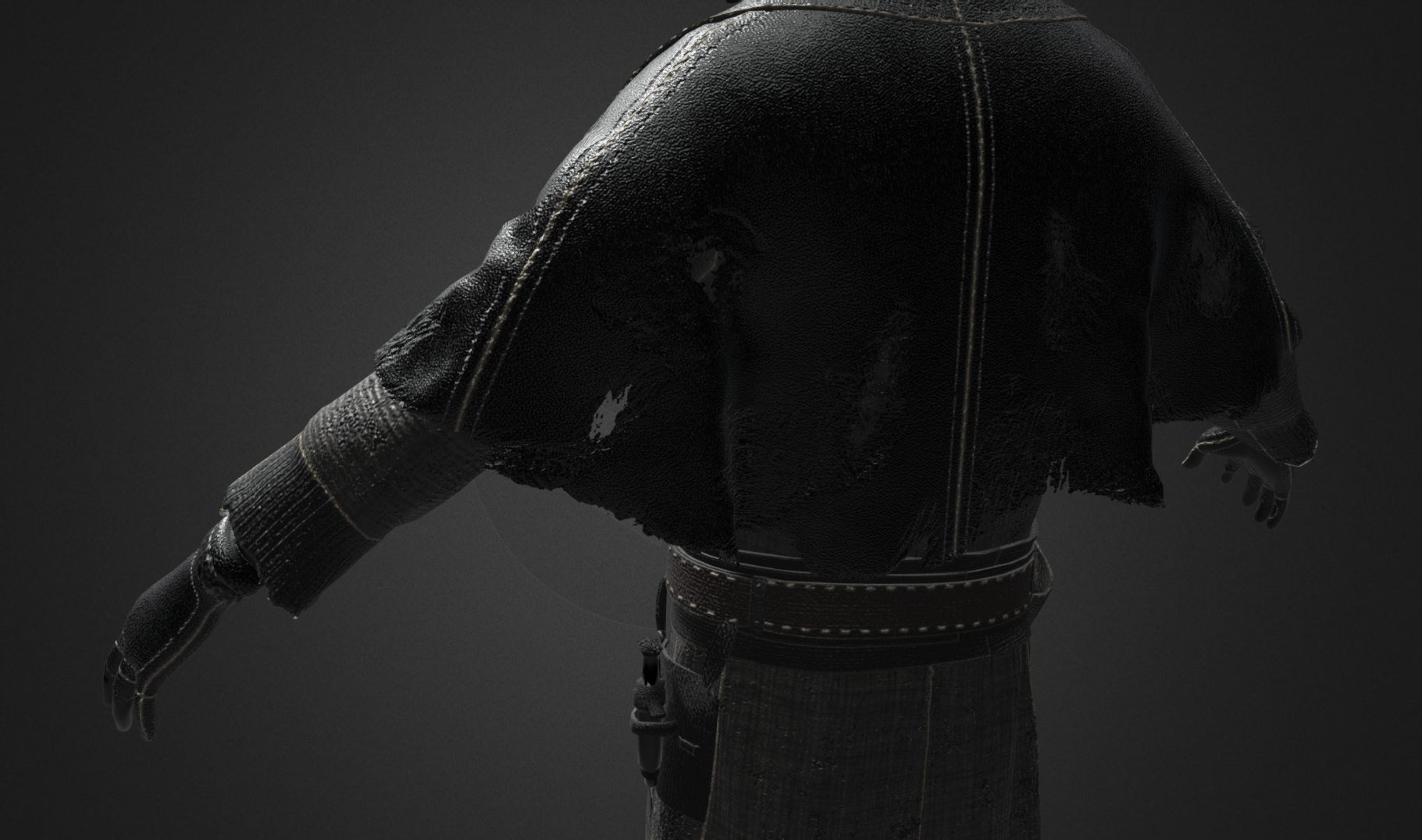
What was the inspiration for your entry?
Ante: I was inspired by H.P Lovecraft’s gothic and cosmic horror stories. I was also inspired by the game Bloodborne, and in particular a character named Eileen the Crow, a hunter of hunters. I came up with the idea of making something Bloodborne-ish for the contest. I also did a little bit of research on what people on the Hunt Discord wanted to see. Many wanted to see a plague doctor hunter, so I made one for them to see how it would look inside of the game.
The support that I received was overwhelming, and it encouraged me to refine it further and make it look better. I knew that most people would try to make hoods, capes, bandoliers filled with bullets, and so on, so I wanted to make a character that would stand out from the crowd. It is a character that cares about his fashion rather than anything else, and by looking at his posture, it can be seen that he is a gentleman, wanting to separate himself from the other hunters in Bayou. There is a mysterious sickness, or a plague going on in Louisiana, turning people into mindless husks thirsting for human flesh. The plague doctor is here to find out what is causing it and to prevent it!

- Dowon's entry is inspired by traditional Korean hunter garments of the 1900s - including the iconic gat hat.

Dowon: Although Hunt: Showdown is set in the south of the United States in the 1900s, I tried to change the idea to what it would look like in my country. The concept of Hunt is mainly a hunter who hunts a supernatural or realistic threat. Korea is a mountainous area and has been threatened by tigers since ancient times. The tiger has long been called the “Lord of the Mountain” and is an element in many myths. Therefore, for a long time, there have been groups belonging to the royal family that specialize in hunting tigers using bows and spears.
In the 1900s, in Korea, exchanges with foreign countries began in earnest, and so bows and spears for catching tigers were turned into guns and bombs. I decided to borrow some of the regional and periodic points of this time. So, I wanted to incorporate the image of a traditional hunter using a gun to hunt 'monsters' into Hunt: Showdown. Although I couldn't set up multiple and really deep concepts because I couldn't afford to spend a lot of time in the contest, I kept the concept simple and focused on expressing the required form.
Although armed with advanced gunpowder weapons and equipment, efforts have been made to keep the old Korean clothing somewhat maintained. I tried to balance it so that it was not too modern or too ancient. For example, leather boots were commonly by soldiers at the time, while the top was in the form of a traditional burlap material, but it also showed a slightly western long coat form.
I wanted a traditional Korean piece to finish my work, so I chose the gat, a traditional-style hat. If you've ever seen the Korean drama 'Kingdom' on Netflix, you've seen a lot of cool gats!
Do you have any tips for fellow community members who want to enter?
Dowon: If you try to create a strong image with too many parts or elements, the overall appearance may be too complicated and confusing. If you've added a lot of detail to one aspect, it's a good idea to balance the other part with a simple form. If the shape is complex, the detail of the surface can be simple. And if the shape is simple, filling in the details, for example, by using patterns, gives good visual guidance. Elements like buttons and stitches that are small or subtle can be exaggerated in size compared to the real thing to give a better visual impression.
Ante: I'd suggest getting familiar with Marvelous Designer! It has a free trial and helpful tutorials that can improve your garment making process. I'd also recommend learning more about poly count and optimization. Most of the characters in games are made with around 15k faces, so it is always wise to make a low poly model and a high poly one. All of those details that you see in professional models aren't really part of the mesh model but are made out of textures that are tricking your eyes into seeing surface details that aren't actually there. That is done by baking the normal map of a detailed high poly model, one that has wrinkles, scars, stitches, and other details onto a low poly one. This means that you can have an optimized model with a low poly count that looks like it is a high poly model that can be used in your games.
I would recommend using up to three texture sets for their entire model and combining the parts rather than using one texture set for every single part. This will pay off later in the performance of the game, and your texture sets won’t have an absurd file size, which can go up to a couple of gigabytes if a lot of texture sets are being used! Also, not everything on your model has to be in 4k. Use 4k textures only on the pieces that you are proud of, and want to draw attention to. Tiny details can be done with textures of a much lower resolution, and still look great on your model.
If parts of your model are transparent once you put them in the engine, like if someone looks inside of the sleeves of your shirt, or coat, try adding thickness to the edges of your model to cover it up. There is no need for you to make an entire model thick, as it will result in a much higher poly count for no reason. Also, make sure to delete the parts of your character's body that are covered up with the clothing. It will be much more optimized, and those parts won't be visible anyway.
What are your favorite features in CRYENGINE?
Dowon: My favorite feature is the real-time GI function in SVOTI. I think that it is excellent for building realistic lighting easily and quickly, and puts only a small burden on specifications. I am looking forward to the upgrade of the ray-traced reflection in the future. I also love the time of day settings functions and the designer tools that allow you to create white boxes within the editor quickly. The shaders have all the necessary functions without requiring any additional programming modifications, and that’s another advantage of CRYENGINE. I think CRYENGINE is a perfect tool for artists.
Ante: My favorite feature would be the lighting because of how nice the textures look once they are lit by the projector light or the sun. It makes the specular map look amazing, adding more to the depth of the scene. I also like the rain. The rain looks terrific, and everything about it can be customized. I spent a lot of time playing around with it, adding more puddles, adjusting the speed, and making the scene as scary as it can be. Another of my favorite features is volumetric fog. It looks so good once you get to see the sun rays piercing through it. And once again, everything about it is entirely customizable and easy to adjust.
The best thing about CRYENGINE, in my opinion, is how easy it is to set up a beautiful looking scene without needing any programming knowledge. It is a great thing for artists!
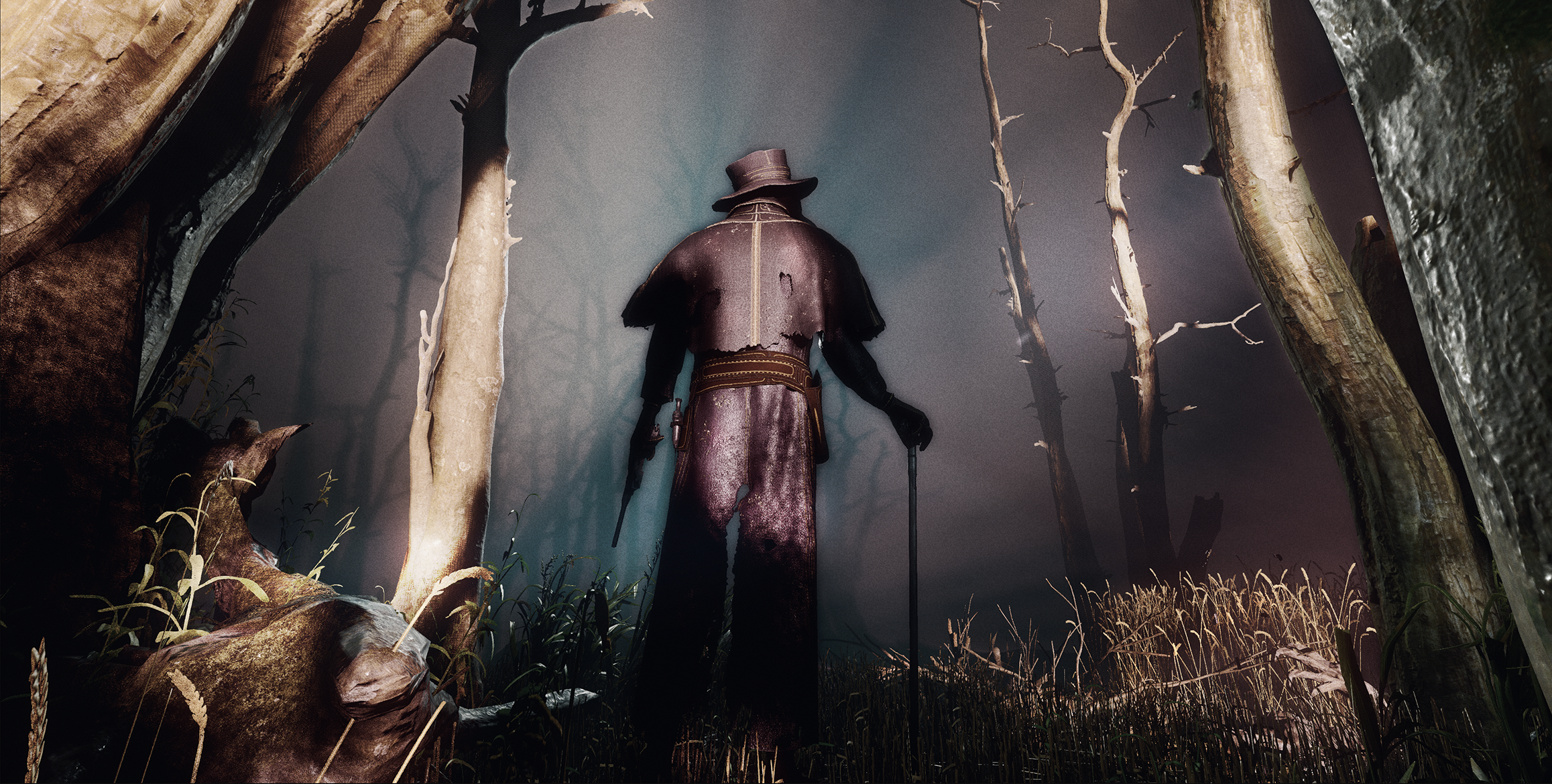
How has the CRYENGINE community helped you on your game dev journey?
Dowon: I am always learning from the community, and especially on the Discord channel, which is really great because I can get help with difficulties quickly. Big thanks to the guys on there, because there are always 'hidden experts` in the community! The same goes for the Crytek staff. On Discord, information and feedback can be learned quickly, so I recommend that you sign up!
Ante: There were a lot of members from the community that helped me, and I really appreciate all of the time and patience they showed me. I want to thank CRY-Nic for being there and supporting me. Always friendly and a nice guy that was always ready to answer any questions that I had, and even encouraging me to start doing what I really like! He was a big inspiration, a person that made me start following my dreams, and I'll be forever grateful. Nic is MVP! :)
I would also like to thank CRY-Josh for taking his time to explain to me how to handle materials, and how to import textures into CRYENGINE, a great guy! I would also like to thank VinnieMc for explaining to me how transparency works in CRYENGINE. All of those torn clothing details would not be possible without him! He is also a great guy who helps everyone, and I appreciate his help!
Cheers, guys!
We hope that these insights have inspired you, and we can’t wait to see what you come up with. Don’t forget that you can connect with us and fellow devs on the forum, or via Facebook and Twitter. You can ask questions, pick up tips and tricks, and more by joining our community and the CRYENGINE development team over on our official CRYENGINE Discord channel. If you find a bug in the engine, please report it directly on GitHub, which helps us to process the issue quickly and efficiently. Don’t forget to subscribe to our YouTube channel, where we host a range of content, including tutorials covering all aspects of the engine and game design.
Are you looking for your next career move? At Crytek, we value diversity, and we actively encourage people from all kinds of backgrounds and experience levels to apply to our open positions, so join us over at LinkedIn and check out our careers page.
